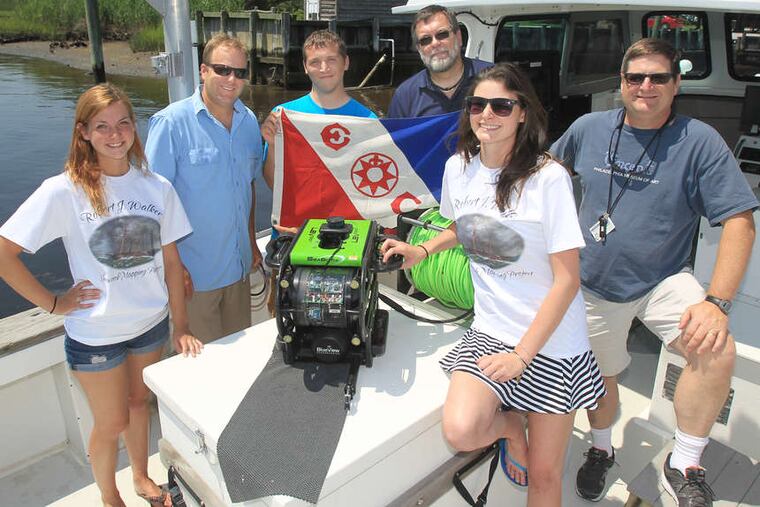Mapping a deadly 1860 shipwreck off Atlantic City
PORT REPUBLIC, N.J. - A remotely operated vehicle - with embedded camera - was lowered over the side of the survey boat and slowly dropped through the ocean depths.

PORT REPUBLIC, N.J. - A remotely operated vehicle - with embedded camera - was lowered over the side of the survey boat and slowly dropped through the ocean depths.
Ten, 20, 30 feet. The tethered vehicle, guided by sonar through murky green waters, began picking up faint images about 85 feet down.
Parts of a ship's metal frame and iron-plated hull jutted from the silt. Anchors, a large steam engine, and the hubs of side-mounted paddle wheels stood like headstones in a graveyard. And the bow, bent back probably by its impact with bottom, still pointed toward land.
Here was the last resting place of the Robert J. Walker and many crew members who died in 1860 when the steamer collided with the schooner Fanny in storm-tossed waters 12 miles off Atlantic City.
Video and side-scan sonar images were collected during four June and July expeditions as part of efforts to survey and map the site for the first time, giving recreational divers and history buffs a clearer picture of the wreck.
This week, up-close information will be gathered during diving expeditions to help complete the project and create a detailed illustration.
"This is what I live for," said Steve Nagiewicz of Brick Township, co-leader of the expedition, science teacher at Atlantic City High School, and former executive director of the Explorers Club. "It's the history of man against nature, a battle man can never win."
"Twenty men died trying to save that ship," he said. "They lost their lives by pure accident, and it was sad and tragic."
The privately funded mapping work is being undertaken by the Richard Stockton College of New Jersey; the New Jersey Historical Divers Association; Black Laser Learning in Wilmington; the Edward Marsh Library in San Diego; and local recreational scuba divers in partnership with the National Oceanic and Atmospheric Administration.
It will be used to produce markers to be displayed in coming months at museums and on the Boardwalk in Atlantic City. Waterproof site maps will be posted for divers touring the wreck.
The Walker was positively identified last year by NOAA and listed this year on the National Register of Historic Places.
"Just being on the site, you think of what happened long ago," said Steve Evert, manager of Stockton's Marine Science and Environmental Field Station at Port Republic, from which he and others departed each time for the wreck. "You envision what happened to these guys, what they went through, and it gives you a feeling of respect for them."
Joining Evert, Nagiewicz, and others were a Stockton professor of biology and three students in a marine technology class who helped collect wreck data.
The Walker, a 358-ton ship launched in 1847, was used by the U.S. Coast Survey - NOAA's predecessor - to survey the depths of ports to facilitate maritime commerce.
This mapping project "is about bridging the future with the past," said Vince Capone, owner of Black Laser Learning, a marine technology training company. "What was being done in the 1800s is important today to commerce, fishing, and recreation.
The Walker crew was "using a piece of line and a lead weight to measure the water depth," said Capone, a Blackwood native and side-scan sonar expert. "These days, students are using the latest acoustic technology.
"This allows the younger generation to not only appreciate historical events, but also utilize new technologies while understanding the older technologies."
The deteriorated Walker, one of the first iron steamers built for the U.S. government, is the graveyard of the 20 men lost when it went down on June 21, 1860. Another man died the next day from his injuries.
At the site, divers have found bits and pieces of the 19th century: Mason's ironstone china, a single cannonball, and unusual rectangular brass portholes.
Seeing the ship's remains "is not so much chilling as it is a reverent experience," said Dan Lieb of Neptune, co-expedition leader and founder of the New Jersey Historical Divers Association. He will dive on the wreck this week. "You're looking at a landmark, a signpost in the history of the United States."
As the Walker steamed toward New York in a gale, its executive officer, Joseph Seawell, spotted the approaching Fanny, which was carrying 240 tons of coal to Boston.
Though both ships were clearly lighted, they somehow collided at 2:15 a.m., with the Fanny's bow anchor striking the Walker's bow, opening hull plates and destroying two lifeboats.
Some crew members tried to plug the hole with blankets and bedding, still visible in the bow of the wreck. Others used axes to chop down the mainmast for use as a flotation device.
Seawell, his wife, and Capt. John McMullen survived, along with more than 40 others. They were rescued by a passing schooner, the R.G. Porter, and the Fanny limped into Cape May.
"When you're out there, looking toward Atlantic City at Absecon Light, you're looking at the same lighthouse [the crew] saw," said Peter Straub, a Stockton professor of biology who was part of the survey team on the 28-foot research vessel Gannet.
Added Stockton student Jamie Taylor of Berlin: "I can't imagine what it would have been like . . . to see the lighthouse and not be able to do anything about it."